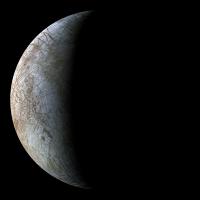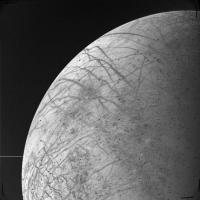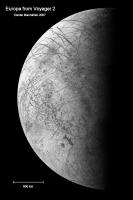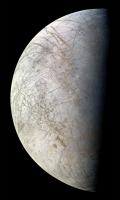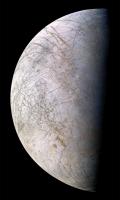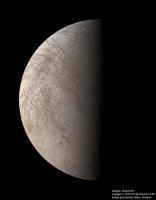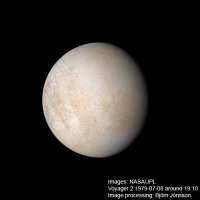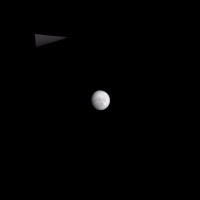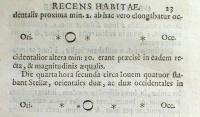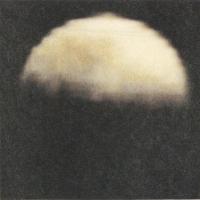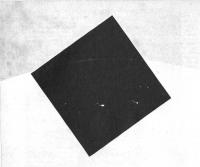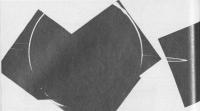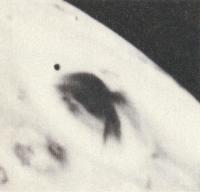Printable Version of Topic
Click here to view this topic in its original format
Unmanned Spaceflight.com _ Jupiter _ 30th Anniversary Voyager 2 at Europa
Posted by: DrShank Apr 9 2009, 01:31 PM
It seems to be a season of anniversaries over the next year or so.
20 years since Voyager 2 at Neptune (see my posting there), 30 yrs since Voyager 1 at Io,
30 since Voyager 2 at Europa, 30 years since VEJUR at . . . . well never mind!
plus all the Galileo 400th commemorations (I will have more on that next week).
I thought it would be a good time to start a thread on this one, which occurred on a
tuesday morning in July 1979. Although the images had been taken on July 9, they were
recorded for playback the next day. I was a mere summer intern in those days and was attending
the morning briefing along with the rest of the Sci Support Team of which i was a member.
Linda Horn and Ellis Miner were my gurus that wonderful summer. Playback was scheduled for
sometime between 8 and 9, as i recall, and I can still remember looking up at the monitor
as the first high resolution images ever seen of Europa first appeared. Wonderful, even
tho only 2 kilometers in resolution. Little did I know where it would lead me . . .
Here is a restored version of one of the two mosaics returned that day. They hint at some of
the exotic things that Galileo later discovered.
cheers
paul
Posted by: elakdawalla Apr 9 2009, 03:16 PM
Those images never get old. I can't imagine what it must have been like to see the surfaces of the Galilean satellites for the first time. Keep the reminiscences coming, Paul.
--Emily
Posted by: tedstryk Apr 9 2009, 03:41 PM
Beautiful! What did you use for color?
Posted by: DrShank Apr 9 2009, 08:49 PM
I dont remember! so many versions of this and that . . . probably global Galileo color mosaic.
Posted by: cbcnasa Apr 10 2009, 04:13 PM
Thank you that is a fantastic image I forgot some of the quality from then. ![]()
Posted by: DrShank Apr 10 2009, 05:16 PM
cool. Alas, this is as close as Voyager ever got. I think it is 1.7 km/pixel, not 2 as i said earlier. It left a lot of people
wondering what was going on inside, but it was more than enough to show Europa was very young indeed
and potentially active (a question still completely unanswered by the way!!). Galileo brought the house down, so to speak.
these are the images i used to show that there was plate tectonics on Europa, an idea that met with a lot of resistance.
paul
Posted by: PhilCo126 Apr 11 2009, 02:42 PM
Indeed the scientific community had to wait for the "Millennium flyby" of Jupiter to get great images of Europa. Resolution in the Voyagers' images was too poor and no features were named on this icy moon. However, three new feature terms were adopted:
Flexus = cuspate linear features
Linea = straight lines
Macula = circular dark areas
Post Scriptum: shouldn't this be moved to the Pioneer/Voyager subforum ![]()
It fits in just fine here.
Posted by: tedstryk Apr 11 2009, 04:42 PM
Actually, that would be Galileo. Not sure what on earth the millennium flyby has to do with it, since Cassini went nowhere near Europa and Galileo's Europa phrase was over.
Posted by: DrShank Apr 11 2009, 04:54 PM
Several dark bands and three craters got named by Voyager! (and a few other things too). 1.5 km is quite enough to
begin to understand a planet, but not do serious mapping. Voyager was constrained by its trajectory, and it got
500 m resolution on Io, Ganymede, Triton, and Rhea, and 250 meter on Miranda. It pales to Cassini, although Cassini get very little
area coverage at better than 100 meters
Posted by: PhilCo126 Apr 11 2009, 05:07 PM
Ted, wasn't it about the "Millennium Flyby" that the first detailed maps came out of the Galilean moons. I remember something of not to worry about Io's map as a map made today would be obsolete tomorrow due to the volcanic eruptions.
Well, I guess that the Voyager images were good enough to make the first preliminary pictorial maps of the Galilean moons. However, NASA published a dedicated "Voyager 1 and Voyager 2 Atlas of Saturnian satellites" (NASA SP-474) in 1984 but didn't publish something similar after the 1979 Jupiter encounters?
![]()
Posted by: DrShank Apr 12 2009, 04:27 AM
Well, I guess that the Voyager images were good enough to make the first preliminary pictorial maps of the Galilean moons. However, NASA published a dedicated "Voyager 1 and Voyager 2 Atlas of Saturnian satellites" (NASA SP-474) in 1984 but didn't publish something similar after the 1979 Jupiter encounters?
The USGS published the preliminary Voyager and later updated Gal Sat maps as fold-out maps. they were never hardcopied.
my Atlas of the Gal Sats will be published by Cambridge late this fall. The Saturn satellite updated maps are being handled as on-line products.
paul
Posted by: PhilCo126 Apr 12 2009, 08:28 AM
Indeed, the only Galilean moon maps I've found are in NASA SP-439 "Voyage to Jupiter" (1980) showing Mercator projections at scale 1:25000000 and Polar stereographic projections at scale 1:13980.
Thank You for the update Paul, and I'm certainly looking forward to Your upcoming book!
Posted by: DrShank Jul 9 2009, 02:32 PM
happy 30th Europa!!!
july 1979 we got our first good look and have been scratching our heads ever since. I remember that warm sunny july morning long ago when you first appeared on our monitors. true it was a distant view (having drawn the short stick in the Voyager satellite pool), but Galileo got a much better view 2 decades later. Still it doesnt quite match the thrill of that first look 30 years ago today.
Posted by: nprev Jul 10 2009, 12:17 AM
Well, I'm officially an Old Dude...brings back so many pleasant memories that seem like just yesterday. 30 years...wow.
Thanks, Paul!
Posted by: DrShank Jul 10 2009, 12:45 AM
Thanks, Paul!
I would have written more but my connection this morning took 1 hour to write one sentence . . .
I was indeed an intern on the Voyager project but not on imaging. rather it was for Ellis Miner on the Science
Support Team, which was responsible for all the planning and execution of the plans. It gave me a healthy respect for those who did not get to appear on camera for the interviews. But also i got to see an encounter as it happened because the images went straight to the JPL TV monitors. Not like Galileo or Cassini which does not quite do that. Jupiter grew larger each day and then on the last day the satellites flashed by quickly. We even had access to quick printers that allowed us to make fast thermal prints. these prints turned black in the sunlight and although i kept some, I have since lost track of those historic photos. I landed in Pasadena a week before the encounter so they immediately put me to work . . . making xeroxes! but i was cool. it was the center of the universe for one week! I relished every minute of it. plus later that summer I was able to make prediction maps for the Saturn moon image due in 1980 and 1981.
paul
Posted by: volcanopele Jul 10 2009, 02:35 AM
Coolness!
I uploaded a new post to my Io blog about this anniversary, and yes, I do talk about Europa with out saying anything derogatory:
http://gishbar.blogspot.com/
Posted by: machi Nov 10 2009, 12:17 PM
Second mosaic taken by Voyager 2. Its in lower resolution (2,23 km/pix) and monochrome, but it has slightly better coverage.
Posted by: tedstryk Mar 12 2010, 02:10 PM
I posted ahttp://planetimages.blogspot.com/2010/03/europa-from-voyager-2.html with my version of this mosaic.
Here are the two variants of the image, one with the color balance mixed between the actual data and an OGV overlay, the second weighing more heavily on the OGV overlay.
Posted by: Bjorn Jonsson May 20 2013, 11:17 PM
Available color data for Europa is so severely limited that reprocessing the Voyager data is still rewarding after all these years. Here is my version of the Voyager 2 color mosaic from 240,000 km. It's a mosaic of 5 color frames, each of which is composed from orange, blue and violet images:
This is actually the *only* hi-res Voyager color observation of Europa (that is, if 2.4 km/pixel qualifies as "hi-res"). The second highest resolution Voyager color observation is this one by Voyager 2 from 1.2 million km - note the color difference between the dark terrain at left and the dark terrain at right:
Both of these images are shown slightly bigger than their original size to compensate for the slight loss of resolution due to resampling in some of the image processing steps. They have also been sharpened a bit for the same reason.
These images highlight the really poor color coverage of Europa (in particular, both Voyagers obtained better color coverage of both Ganymede and Callisto). Galileo obtained a 1.4 km/pixel IR756-GR-VI mosaic during its E14 orbit showing largely the same terrain as the Voyager mosaic. There are several versions of the E14 mosaic in circulation; the best known one is probably Ted's version. The Galileo E14 data is almost global but has some gaps. There is also a partial 1.6 km/pixel color image from G1 and a very noisy 1.4 km/pixel color image from E12. In addition there is near-global coverage at much lower resolutions (by far the best one is the 7 km/pixel global G2 image). In addition there are some high resolution color samples but these are extremely limited in coverage.
Some notes on the color processing in the mosaic above:
I used the calibrated and geometrically corrected Voyager images available at the PDS Rings Node as source data. The flatfielding in these images is exquisite; this is particularly important when mosaicking images showing rough terrain near the terminator. The only drawback is that in my opinion the reseau removal could be better in some cases - sometimes an excessive number of pixels gets smoothed but this is easy to fix in Photoshop once the color channels have been aligned.
Voyager 2 was imaging Europa using the orange, blue, violet and ultraviolet filters. At first glance this may not seem ideal since there are no green filter images but things are not that simple. The effective wavelength of the Voyager filters is OR=589 nm, GR=564, BL=475, VI=402 and UV=332. One important thing to note is that there are only 25 nm between the OR and GR filters (and lots of overlap.) This makes it rather difficult to create synthetic red from OR and GR by extrapolating - the results are usually bad (it should be noted though that the OR and GR filters are pretty different even though 25 nm isn't a big number). I usually get much better red images by using OR and BL (or even VI when BL isn't available). Luckily, Voyager 2 acquired test images of Jupiter using all of the filters at the start of its approach phase and these can be used for checking various filter combinations. C1838155 is the first one of these images. I used these as 'ground truth' when testing various ways of making synthetic images (red etc.) since I have a pretty good idea of what Jupiter's color should look like. Once I had acceptable color of Jupiter from OBV images I used identical color processing for Europa. I'm fairly happy with the resulting color - in particular I get very similar color when processing the Galileo E14 stuff even though the filters used are different. I also experimented with interpolating the data to get the entire visible spectrum and then converting it to sRGB. The results were similar (slightly stronger green color component though).
For the interested, the synthetic colors were created using these formulas:
R = 1.526315789 x OR - 0.52631579 x BL
G = 1.01 x (0.719298246 x OR + 0.280701754 x BL)
B = 1.07 x (0.726027397 x BL + 0.273972603 x VI)
This results in fairly realistic images of Jupiter with whitish zones etc. - the 1.01 and 1.07 values are there mainly to make the zones more whitish. The 'target wavelengths' here are R=649 nm (the Cassini red filter), G=557 nm (the Galileo green filter) and B=455 nm (the Cassini blue filter). The Cassini green filter is 569 nm which is too close to yellow for my taste. This approach might work fairly well for the entire Voyager 2 Jupiter data since the source data is calibrated but I need to check that more carefully. In particular, Io is a likely exception because of its weird spectrum.
The original data had some gaps but they aren't big and in all cases two colors are available, making it possible to fill the gaps using synthetic data. The location of the missing data can be seen in this ancient version that was released back in 1979:
http://photojournal.jpl.nasa.gov/catalog/PIA00366
Posted by: tedstryk May 21 2013, 02:29 AM
Beautiful work! This is the same dataset as I used in the previous post in this thread.
Posted by: Bjorn Jonsson May 21 2013, 11:35 PM
Yes, the same dataset with one exception: I didn't use any of the wide angle images for color, I only used narrow angle data. The drawback of this is the absence of green filter data but as mentioned above I don't think that's a big issue. But it's not always easy to know exactly how accurate the resulting color is.
One 'crazy' color processing idea I have is to somehow use Europa's entire visible spectrum together with the color information from spacecraft images to compute an entire synthetic, visible spectrum for each point in an image and use this to make synthetic R/G/B. I'm not sure exactly how I would do this but this would replace the linear interpolation that is usually used, both when mixing the color channels as I did above and also when the entire visible spectrum is created from (usually) three filters and then converted to sRGB. I doubt this will work very well though but I'm interested in trying it. One obvious complication is that the leading and trailing hemispheres have slightly different spectra and obviously the spectrum of a dark feature is different from the bright terrain. And there is no spectral information available in visible light that resolves these small (relative to Europa itself) features and also has high spectral resolution.
Posted by: tedstryk May 22 2013, 01:08 AM
I focused mostly on stacking images to get the best feature clarity possible and, as a last minute "oh, that would be nice" figured I should have some color. I must say I am impressed...that's the most accurate color I've ever seen for Europa from Voyager filters.
Posted by: machi May 24 2013, 12:18 PM
Excellent images!
Posted by: JRehling May 25 2013, 08:12 PM
Bjorn, I share your crazy dream. I think Europa's entire surface can be represented fairly well as a pointwise blend of three or four surface components. Then the subtasks would be:
1) Determine the Hapke parameters of each of those components, based on areas where the surface is a relatively pure representative of that component.
2) Determine for as much of the surface as possible, what the local coefficients are that weight how much the various components contribute.
Once this process came along, it would probably be possible to make some pretty good estimates of (2) based even on single-filter images.
And then one could render realistic color images of much of the surface of Europa even where no such images have been captured.
Posted by: owlsyme May 30 2022, 06:48 PM
Here's a gif of Voyager 2's flyby of Europa
Video from https://www.youtube.com/watch?v=Dan3lPxEXZw
Posted by: Phil Stooke May 30 2022, 08:58 PM
I tried to explain to students how amazing Voyager was but not sure they were convinced. The first time anything like a reasonable survey of the four outer planets was accomplished. When you have the cornucopia of Cassini treasures or even the highly restricted Galileo data set, Voyager looks weak in comparison, but what did we have before it? I still remember the first images coming in from Voyager 1 at Jupiter, Larry Soderblom saying of Io 'This one we've got all figured out', the news conference with the discovery of Io's volcanic plumes. Imagine the audacity of people in 1972 saying they could build something that could fly to Neptune and lay the foundation of outer solar system research the way Voyager did! Nowadays we feel we can do anything if the money can be found but that wasn't true back then.
Phil
Posted by: owlsyme May 31 2022, 01:08 AM
I grew up with the Voyager images coming back, seeing them on the news and in magazines - maybe that's why I find them so fascinating...
A friend's uncle worked at JPL or NASA and gave him some of those 8x10 pictures that they used to put out - Jupiter's red spot, Europa, Io. They were mind-blowing!
Here's what Gallileo saw of Jupiter and its moons -
and what Pioneer saw of Europa in 1973 -
and Voyager, from an interesting book from 1980, Voyage to Jupiter - https://www.gutenberg.org/files/58915/58915-h/58915-h.htm - lots of old color composites of Jupiter and the moons -
lightning -
rings -
volcano on Io -
Powered by Invision Power Board (http://www.invisionboard.com)
© Invision Power Services (http://www.invisionpower.com)
